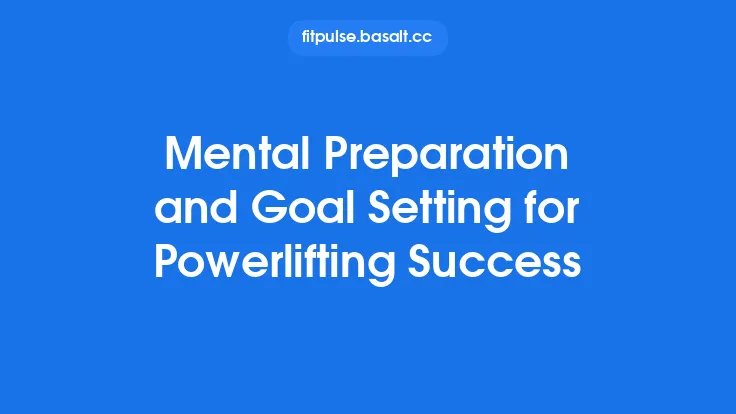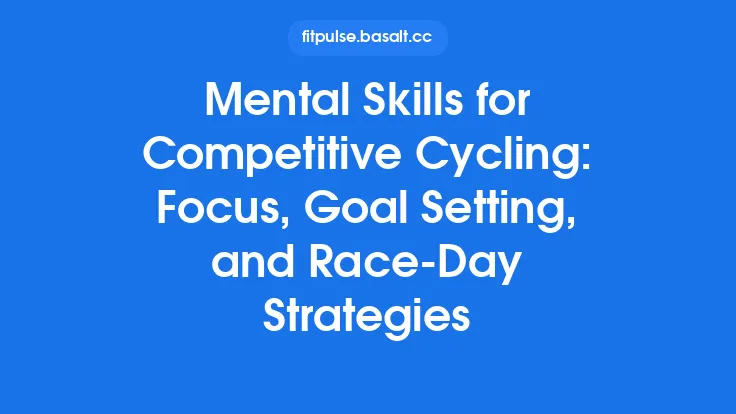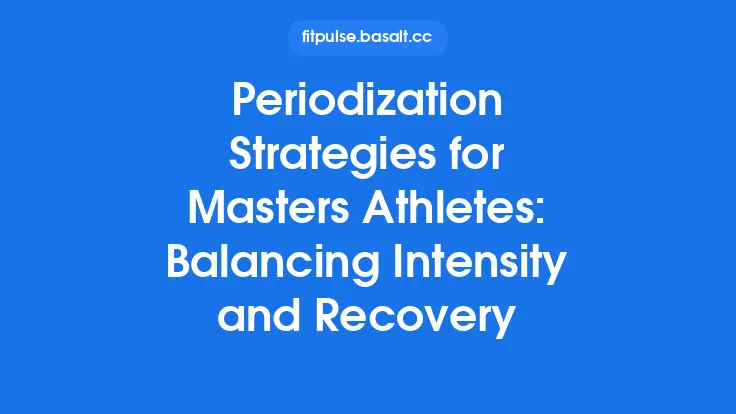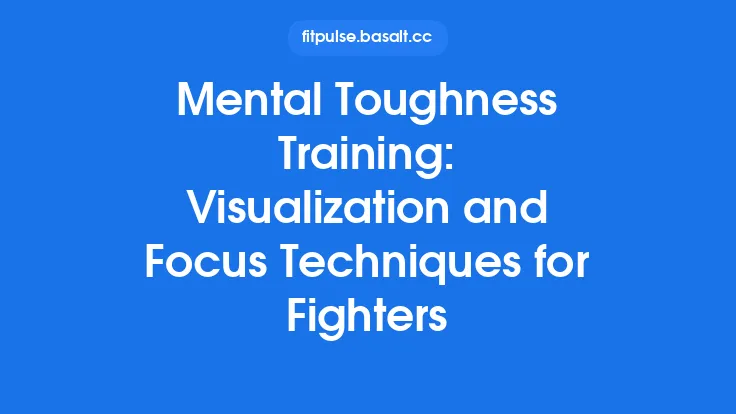Competing as a master athlete—whether you’re sprinting on the track, rowing on the water, or cycling up a mountain—requires more than just a well‑designed physical program. The mental game often determines whether you simply finish a race or truly thrive in the sport you love. For athletes over 40, the interplay between mental resilience and purposeful goal setting becomes a cornerstone of sustained performance, enjoyment, and personal growth. Below, we explore the science, strategies, and practical tools that help master athletes cultivate a resilient mindset and set goals that keep them motivated, focused, and adaptable throughout their athletic journey.
Understanding Mental Resilience in Masters Athletes
Definition and Core Components
Mental resilience is the capacity to maintain or quickly regain psychological equilibrium in the face of stress, setbacks, or adversity. For master athletes, resilience comprises several interrelated components:
- Emotional Regulation – Managing anxiety, frustration, or excitement without letting them derail performance.
- Cognitive Flexibility – Shifting perspective when plans change (e.g., a missed training session or an unexpected race condition).
- Self‑Efficacy – Belief in one’s ability to execute specific tasks, which fuels persistence.
- Optimism and Positive Reappraisal – Interpreting challenges as opportunities for learning rather than threats.
Why Resilience Matters More With Age
Physiological changes—slower recovery, increased injury risk, and altered hormone profiles—can amplify the psychological impact of setbacks. A resilient mindset helps master athletes:
- Maintain Consistency: Avoiding the “all‑or‑nothing” mindset that can lead to prolonged training gaps.
- Adapt Training Loads: Accepting that some weeks will require modification without feeling defeated.
- Preserve Motivation: Keeping the intrinsic love for sport alive despite external pressures (work, family, health).
Neuroscience Snapshot
Research shows that regular mental training (e.g., mindfulness, visualization) can strengthen the prefrontal cortex, the brain region responsible for executive control and emotional regulation. In older adults, this neuroplastic adaptation helps counteract age‑related declines in processing speed and working memory, directly supporting better decision‑making during competition.
The Psychology of Goal Setting
Goal‑Setting Theory Basics
Edwin Locke’s Goal‑Setting Theory posits that specific, challenging goals lead to higher performance than vague or easy ones. The theory rests on three pillars:
- Clarity – Clear, unambiguous goals reduce uncertainty.
- Challenge – Goals that stretch abilities increase effort.
- Commitment – Personal investment ensures persistence.
Goal Types for Master Athletes
| Goal Category | Description | Example for a 55‑year‑old triathlete |
|---|---|---|
| Outcome Goals | Focus on final results (e.g., podium finish). | “Place in the top 10 at the regional Ironman.” |
| Performance Goals | Target specific metrics (time, distance, technique). | “Complete the 3.8 km swim in under 55 minutes.” |
| Process Goals | Concentrate on actions or habits during training/competition. | “Maintain a steady breathing pattern during each 500 m interval.” |
Outcome goals are motivating but can be heavily influenced by external factors. Process and performance goals provide more control, making them especially valuable for athletes navigating the variability that comes with age.
Developing a Resilient Mindset
1. Reframe Setbacks as Data
Instead of labeling a missed PR as failure, treat it as a data point. Ask: What does this tell me about my current training, recovery, or mental state? This analytical approach reduces emotional reactivity.
2. Build a “Resilience Routine”
Incorporate daily mental practices that reinforce resilience:
- Morning Intentions: Briefly state the mental quality you’ll focus on (e.g., patience, confidence).
- Mid‑Day Check‑In: Pause for a 2‑minute breath awareness exercise to reset stress levels.
- Evening Reflection: Write a short journal entry noting one challenge faced and how you responded constructively.
3. Embrace the “Growth Mindset”
Carol Dweck’s research highlights that athletes who view abilities as developable (rather than fixed) are more likely to persist after setbacks. For master athletes, this means believing that speed, strength, and technique can improve with deliberate practice, even if progress is slower than in youth.
4. Leverage Past Successes
Create a “mental archive” of previous achievements—race results, training milestones, personal bests. When confidence wanes, reviewing this archive reminds you of your capacity to overcome obstacles.
SMART Goals for the Masters Athlete
The SMART framework (Specific, Measurable, Achievable, Relevant, Time‑Bound) translates abstract aspirations into actionable plans.
| SMART Element | Guideline | Example |
|---|---|---|
| Specific | Define exactly what you want to achieve. | “Reduce my 5 km run time.” |
| Measurable | Identify a quantifiable metric. | “From 30 min to 27 min.” |
| Achievable | Ensure the goal is realistic given current fitness and life commitments. | “Dedicate three 45‑minute interval sessions per week.” |
| Relevant | Align with broader life or sport objectives. | “Improves race performance and overall cardiovascular health.” |
| Time‑Bound | Set a clear deadline. | “Achieve by the end of the next 12‑week training block.” |
Tip: Break long‑term goals into a hierarchy of sub‑goals. A 12‑month objective (e.g., qualify for a national championship) can be divided into quarterly performance targets, each with its own process goals.
Long‑Term Vision and Short‑Term Milestones
Creating a Vision Board
Visual tools help keep the big picture vivid. Assemble images, quotes, and performance data that represent where you want to be in 5–10 years. Place the board where you train daily.
Milestone Mapping
Plot short‑term checkpoints on a calendar:
- Monthly: Evaluate training logs for consistency and mental fatigue.
- Quarterly: Conduct a “mental audit”—rate confidence, focus, and stress on a 1‑10 scale.
- Bi‑annual: Reassess goals; adjust difficulty or focus based on life changes (e.g., new job, family responsibilities).
By linking each milestone to a specific mental skill (e.g., “improve pre‑race anxiety management”), you ensure that progress is both physical and psychological.
Overcoming Common Psychological Barriers
| Barrier | Underlying Cause | Practical Countermeasure |
|---|---|---|
| Fear of Decline | Awareness of age‑related changes. | Reframe as “experience advantage” and focus on skill refinement. |
| Perfectionism | Desire to match past peak performances. | Adopt “good enough” standards for each training session; celebrate effort over outcome. |
| Comparative Anxiety | Measuring self against younger athletes. | Use personal baselines rather than external benchmarks; track relative improvement. |
| Motivation Slumps | Competing life demands. | Schedule “purposeful rest” days that include non‑sport activities you love; reconnect with why you started. |
| Self‑Doubt | Past injuries or missed races. | Implement a “confidence script”—a set of affirmations rehearsed before each workout. |
Building a Support Network
1. Peer Groups
Joining a masters‑specific training club provides shared experiences and mutual accountability. Group discussions about mental challenges normalize the conversation around resilience.
2. Mentorship
Pairing with a seasoned master athlete who has navigated similar obstacles can offer perspective and concrete coping strategies.
3. Professional Guidance
Sports psychologists or performance coaches trained in adult athlete development can tailor mental‑skill interventions (e.g., imagery scripts, anxiety reduction protocols) to your unique context.
4. Family Involvement
Educate close family members about your training schedule and mental preparation needs. Their understanding can reduce external stressors and create a supportive home environment.
Mental Skills Training Techniques
Visualization (Mental Rehearsal)
Spend 5–10 minutes before each session picturing the exact sensations of a successful performance—breathing rhythm, muscle activation, environmental cues. Research shows that vivid imagery activates neural pathways similar to actual execution, reinforcing confidence.
Self‑Talk Strategies
Develop a repertoire of cue words and phrases:
- Task‑Focused: “Drive the hips,” “Maintain cadence.”
- Motivational: “You’ve got this,” “One step at a time.”
Practice delivering these statements aloud during warm‑ups to embed them into muscle memory.
Mindfulness Meditation
A 10‑minute daily mindfulness practice improves attentional control and reduces rumination. Simple breath‑focus or body‑scan techniques are sufficient; consistency outweighs session length.
Progressive Muscle Relaxation (PMR)
Before competition, systematically tense and release muscle groups to lower physiological arousal. PMR can be combined with imagery of a calm race environment.
Goal Review Ritual
At the end of each week, review your written goals, note progress, and adjust language if needed. This ritual reinforces commitment and provides a structured reflection point.
Tracking Progress and Adjusting Goals
Quantitative Metrics
- Performance Logs: Record times, distances, perceived effort (RPE), and mental state rating after each session.
- Psychological Scales: Use brief validated tools such as the Sport Motivation Scale (SMS) or the Resilience Scale for Adults (RSA) quarterly to gauge mental trends.
Qualitative Feedback
- Journaling: Capture narrative reflections on mood, confidence, and any mental obstacles encountered.
- Coach/Peer Debriefs: Schedule monthly check‑ins to discuss mental challenges and brainstorm solutions.
Adjustment Protocol
- Data Review – Compare current metrics against baseline and goal thresholds.
- Identify Gaps – Determine whether shortfalls are physical, mental, or logistical.
- Modify Goal Parameters – If a goal proves too ambitious, tighten the timeframe; if it’s too easy, increase the challenge level.
- Implement New Mental Skill – Introduce a targeted technique (e.g., a new visualization script) to address the identified gap.
Integrating Mental Resilience into Daily Training
Pre‑Session Warm‑Up
- 2 minutes of diaphragmatic breathing.
- 1 minute of cue word repetition (“focus”).
During Session
- Conduct “micro‑checks” every 15–20 minutes: ask yourself, Am I present? If not, reset with a brief breath pause.
Post‑Session Cool‑Down
- 5 minutes of reflective journaling: note one mental win and one area for improvement.
- End with a gratitude statement related to the training (e.g., “I’m grateful for the strength in my legs today”).
Embedding these micro‑habits ensures that mental resilience is not an isolated activity but a seamless component of every training day.
Case Studies and Practical Examples
Case 1: The 48‑Year‑Old Marathoner
Background: After a 10‑year hiatus, Sarah returned to marathon training but struggled with race‑day anxiety.
Intervention: She adopted a three‑step pre‑race routine—(1) 5‑minute mindfulness, (2) a personalized mantra (“steady and strong”), and (3) a visualization of crossing the finish line with a relaxed stride.
Outcome: Over two races, her perceived anxiety score dropped from 8/10 to 3/10, and her finish time improved by 12 minutes.
Case 2: The 55‑Year‑Old Swimmer
Background: Mark set a goal to shave 5 seconds off his 100 m freestyle but repeatedly missed the target, leading to frustration.
Intervention: He shifted focus to process goals—maintaining a consistent breathing pattern and a relaxed shoulder roll. He logged each practice session’s mental focus rating.
Outcome: Within six weeks, his technique consistency increased (focus rating 8/10), and he achieved a 4‑second improvement, reigniting confidence.
Case 3: The 62‑Year‑Old Triathlete
Background: Linda wanted to qualify for a national age‑group championship but felt overwhelmed by balancing work, family, and training.
Intervention: She created a vision board, broke her 12‑month goal into quarterly milestones, and enlisted a peer accountability partner. She also practiced weekly gratitude journaling to maintain a positive outlook.
Outcome: She met each quarterly milestone, qualified for the championship, and reported higher overall life satisfaction scores.
These examples illustrate how mental resilience techniques, when paired with clear, adaptable goals, translate into tangible performance gains and enhanced well‑being.
Conclusion: Sustaining Performance Through Mental Strength
For master athletes, the competitive edge is no longer defined solely by raw physiological capacity. Mental resilience—cultivated through intentional goal setting, reflective practices, and supportive networks—acts as the glue that holds training consistency, motivation, and enjoyment together. By embracing a growth‑oriented mindset, employing SMART goals, and integrating daily mental‑skill routines, athletes over 40 can not only maintain high performance but also experience richer personal fulfillment in their sport.
Remember: resilience is a muscle. The more you train it—through visualization, mindfulness, and purposeful reflection—the stronger it becomes, allowing you to navigate the inevitable ups and downs of a lifelong athletic journey with confidence, clarity, and joy.




